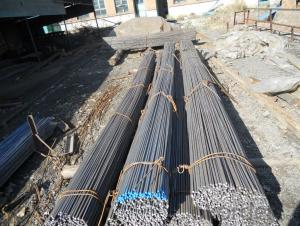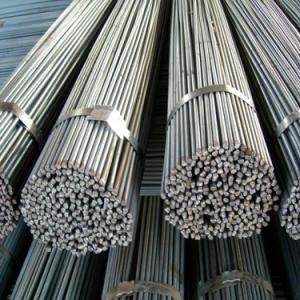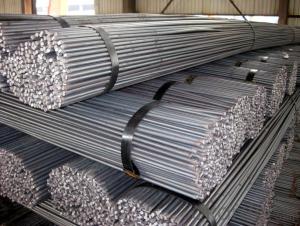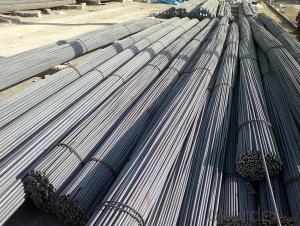Steel Round Bar Made in China with High Quality Hot Rolledfor Sale
- Loading Port:
- China main port
- Payment Terms:
- TT OR LC
- Min Order Qty:
- 25 m.t.
- Supply Capability:
- 2000 m.t./month
OKorder Service Pledge
OKorder Financial Service
You Might Also Like
Item specifice
Product Description:
OKorder is offering Steel Round Bar Made in China with High Quality Hot Rolled for Sale at great prices with worldwide shipping. Our supplier is a world-class manufacturer of steel, with our products utilized the world over. OKorder annually supplies products to European, North American and Asian markets. We provide quotations within 24 hours of receiving an inquiry and guarantee competitive prices.
Product Applications:
Steel Round Bar Made in China with High Quality Hot Rolled for Sale are ideal for structural applications and are widely used in the construction of buildings and bridges, and the manufacturing, petrochemical, and transportation industries.
Product Advantages:
OKorder's Steel Round Bar Made in China with High Quality Hot Rolled for Sale are durable, strong, and resist corrosion.
Main Product Features:
· Premium quality
· Prompt delivery & seaworthy packing (30 days after receiving deposit)
· Corrosion resistance
· Can be recycled and reused
· Mill test certification
· Professional Service
· Competitive pricing
Packaging & Delivery:
Packaging Detail: products are packed in bundle and then shipped by container or bulk vessel, deformed bar is usually naked strapping delivery, when storing, please pay attention to moisture proof. The performance of rust will produce adverse effect.
Each bundle weight: 2-3MT, or as required
Payment term: TT or L/C
Delivery Detail: within 45 days after received advanced payment or LC.
Label: to be specified by customer, generally, each bundle has 1-2 labels
Trade terms: FOB, CFR, CIF
FAQ:
Q1: How soon can we receive the product after purchase? A1: Within three days of placing an order, we will begin production. The specific shipping date is dependent upon international and government factors, but is typically 7 to 10 workdays.
Q2: How do we guarantee the quality of our products?
A2: We have established an advanced quality management system which conducts strict quality tests at every step, from raw materials to the final product. At the same time, we provide extensive follow-up service assurances as required.
Q3: Why buy Materials & Equipment from OKorder.com?
A3: All products offered byOKorder.com are carefully selected from China's most reliable manufacturing enterprises. Through its ISO certifications, OKorder.com adheres to the highest standards and a commitment to supply chain safety and customer satisfaction.
Images:
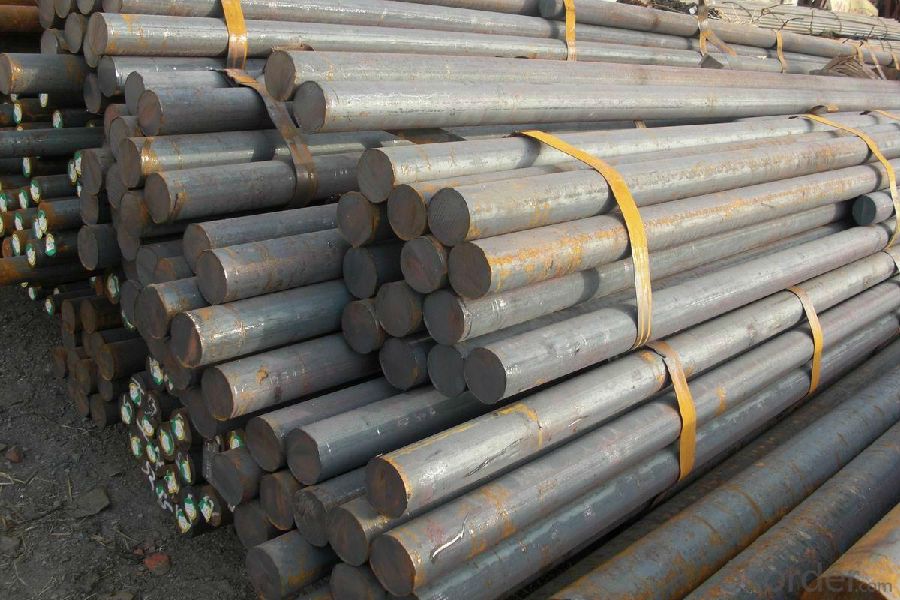
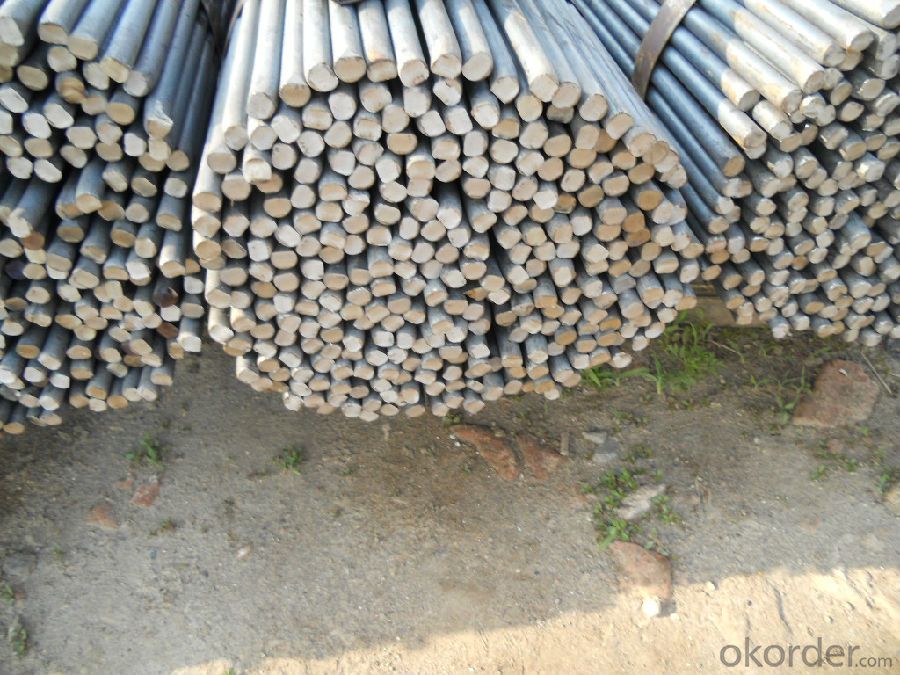
- Q:Are steel round bars used in the aerospace industry?
- Indeed, it is common practice to employ steel round bars within the aerospace industry. Renowned for their exceptional strength, durability, and resistance to corrosion, these round bars prove themselves as an excellent choice for aircraft components and structures. They find frequent application in the creation of landing gears, engine mounts, structural frames, and other pivotal aircraft parts. Moreover, steel round bars are also utilized in the production of aerospace fasteners, such as bolts and screws, owing to their capacity to endure immense stress and establish a steadfast connection. In summary, the pivotal role played by steel round bars in guaranteeing the safety and dependability of aerospace systems cannot be overstated.
- Q:What are the different types of steel round bar surface defects?
- There are several different types of surface defects that can occur on steel round bars. Some of the most common defects include: 1. Scale: This is a thin layer of oxide that forms on the surface of the steel during the manufacturing process. It appears as a rough, flaky or scaly texture and can be easily removed by pickling or abrasive cleaning. 2. Pitting: Pitting is a localized corrosion that appears as small, shallow holes or depressions on the surface of the steel. It is typically caused by exposure to corrosive substances or environments and can weaken the material if left untreated. 3. Surface cracks: These are small, visible cracks that appear on the surface of the steel round bar. They can be caused by various factors such as improper cooling during the manufacturing process, excessive stress, or improper handling. Surface cracks can reduce the structural integrity of the steel and should be carefully inspected and repaired if necessary. 4. Decarburization: This defect occurs when the surface layer of the steel loses its carbon content, leading to reduced hardness and strength. Decarburization is often caused by high temperatures during heat treatment or improper cooling methods. It can be detected through visual inspection or by conducting hardness tests. 5. Lamination: Lamination defects occur when there are layers or flakes within the steel round bar. These layers can cause weakness in the material and compromise its structural integrity. Lamination defects are typically caused by improper rolling or excessive impurities in the steel. 6. Inclusions: Inclusions are foreign materials or impurities that are trapped within the steel during the manufacturing process. They can appear as dark spots, streaks, or irregular shapes on the surface of the round bar. Inclusions can reduce the strength and ductility of the steel and can be caused by factors such as improper raw material quality or inadequate refining processes. It is important to note that surface defects in steel round bars can vary in severity and impact on the material's performance. Regular inspection and quality control measures are essential to identify and rectify any surface defects to ensure the integrity and reliability of the steel round bar.
- Q:What is the tensile strength of steel round bars?
- The tensile strength of steel round bars varies depending on the specific grade or type of steel used. On average, steel round bars possess a tensile strength ranging from 400 to 500 megapascals (MPa). This implies that steel round bars can endure a pulling or stretching force of 400 to 500 MPa before undergoing permanent deformation or fracturing. It is worth mentioning that varying grades of steel, such as mild steel, carbon steel, or alloy steel, may exhibit different tensile strength values. Moreover, factors like heat treatment, manufacturing process, and round bar size can also impact its tensile strength. Therefore, it is advisable to seek accurate and precise information regarding the tensile strength of a particular steel round bar from the specific manufacturer or supplier.
- Q:Can steel round bars be used for making mining equipment?
- Yes, steel round bars can be used for making mining equipment. Steel round bars are commonly used in the manufacturing of various mining equipment due to their high strength, durability, and resistance to wear and tear. They are suitable for applications that require heavy-duty and robust equipment, such as drilling rigs, excavators, crushers, and conveyor systems used in the mining industry. The versatility of steel round bars allows them to be machined, welded, and formed into different shapes and sizes, making them ideal for customizing mining equipment to meet specific requirements. Additionally, steel round bars can withstand harsh operating conditions in mining environments, including exposure to abrasive materials, extreme temperatures, and heavy loads.
- Q:What are the different cutting methods for steel round bars?
- There are several different cutting methods that can be used for steel round bars, depending on the specific requirements and equipment available. Some of the most common cutting methods include: 1. Sawing: This is one of the most basic and traditional methods of cutting steel round bars. It involves using a saw blade with teeth to cut through the metal. Sawing can be done manually with a hacksaw or powered by using a bandsaw or circular saw. It is a versatile method that can be used for both small-scale and large-scale cutting projects. 2. Shearing: Shearing is another common method of cutting steel round bars. It involves using a shear machine or hydraulic press to apply a high amount of force to cut the metal. This method is often used for cutting thick or heavy-duty steel bars. 3. Abrasive cutting: Abrasive cutting involves the use of an abrasive wheel or disc to grind away the metal and create a cut. This method is commonly used for cutting steel round bars with irregular shapes or for precision cutting projects. It can be done manually with a handheld grinder or using a machine like an abrasive cut-off saw. 4. Flame cutting: Flame cutting, also known as oxy-fuel cutting, uses a combination of oxygen and a fuel gas (such as acetylene or propane) to create a high-temperature flame that melts and cuts through the steel. This method is often used for cutting thick steel bars or for shaping metal. 5. Plasma cutting: Plasma cutting is a more advanced method that uses a plasma torch to cut through the steel. The plasma torch generates a high-velocity jet of ionized gas that melts and removes the metal. This method is commonly used for precision cutting, as it allows for greater control and produces cleaner cuts compared to other methods. It is important to note that the choice of cutting method will depend on factors such as the thickness and hardness of the steel round bar, the desired precision of the cut, and the available equipment and resources. It is recommended to consult with a professional or experienced metalworker to determine the most appropriate cutting method for a specific project.
- Q:Can steel round bars be used in the production of musical instruments?
- Yes, steel round bars can be used in the production of musical instruments. Steel is a versatile material that offers a range of desirable properties such as strength, durability, and resonance. While wood is commonly used in the construction of musical instruments, steel can be employed in certain applications to enhance the instrument's sound and performance. Steel round bars can be utilized in the manufacturing of various components, such as keys or valves for wind instruments like saxophones or trumpets. These bars can also be used to create the internal support structures in instruments like guitars or cellos, providing stability and enhancing tonal qualities. Additionally, steel round bars can be used in the construction of percussion instruments such as steel drums or xylophones, where their strong and resonant properties are highly desirable. Overall, while steel is not as commonly used as wood in musical instrument production, it can certainly be employed in specific cases to achieve desired sound characteristics and structural integrity.
- Q:How do steel round bars perform under fatigue loading?
- Steel round bars generally perform well under fatigue loading, especially if they are made from high-quality steel. Fatigue loading refers to the repeated application of stress or strain on a material, which can lead to failure over time. Steel round bars are known for their excellent fatigue strength, which is the ability to withstand cyclic loading without developing cracks or failures. This is mainly due to the inherent properties of steel, such as its high strength, ductility, and toughness. Under fatigue loading, steel round bars undergo cyclic stress, which causes the material to experience alternating tension and compression. However, steel has a relatively high endurance limit, also known as fatigue strength coefficient, which determines the maximum stress level that the material can withstand without failure, even under cyclic loading. Steel round bars also have good resistance to fatigue crack propagation. This means that if a crack does initiate due to cyclic loading, it is less likely to propagate or grow quickly compared to other materials. This is due to the material's ability to absorb energy and redistribute stress, preventing the crack from growing and ultimately leading to failure. However, it is important to note that the performance of steel round bars under fatigue loading can be influenced by various factors. These include the specific type and grade of steel used, the manufacturing process, surface conditions, and the applied stress or strain levels. It is crucial to design and use steel round bars in accordance with industry standards and guidelines to ensure their optimal performance and safety under fatigue loading.
- Q:Can steel round bars be used in the manufacturing of shafts?
- Yes, steel round bars can be commonly used in the manufacturing of shafts. Steel round bars possess excellent strength, durability, and resistance to wear and tear, making them ideal for shaft applications. Additionally, their round shape allows for easy machining and shaping into the desired dimensions and specifications required for shafts.
- Q:What is the tolerance level for steel round bars?
- The tolerance level for steel round bars can vary depending on several factors such as the grade and diameter of the bar, as well as the specific industry standards and requirements. Generally, the tolerance level for steel round bars is specified in terms of diameter or diameter deviation. For example, in the manufacturing industry, the tolerance level for steel round bars can be specified as a specific diameter range, such as +/- 0.001 inches or +/- 0.02 millimeters. This means that the actual diameter of the bar should be within this specified range to meet the tolerance requirements. Additionally, the tolerance level can also be specified in terms of diameter deviation, which refers to the difference between the actual diameter of the bar and the specified nominal diameter. This deviation is usually expressed as a percentage or a specific measurement, such as +/- 0.5% or +/- 0.010 inches. It is important to note that the tolerance level for steel round bars can be more stringent in certain industries, such as aerospace or automotive, where precision and quality are critical. In these cases, the tolerance requirements may be narrower to ensure the bar meets the specific performance and safety standards. Ultimately, it is essential to consult the relevant industry standards, specifications, or customer requirements to determine the specific tolerance level for steel round bars in a particular application.
- Q:How do steel round bars differ from steel square bars?
- The shape and appearance of steel round bars and steel square bars differ. Steel round bars have a circular cross-section and a cylindrical shape, making them suitable for applications that require strength and stability, such as construction, manufacturing, and engineering. Their circular shape allows for even distribution of stress and load, making them highly resistant to bending or twisting forces. They are commonly used as structural components in buildings, support beams, shafts, and axles. On the other hand, steel square bars have a square cross-section with four equal sides and sharp corners. This shape provides additional advantages in certain applications. Square bars offer better grip and handling due to their flat surfaces, making them easier to hold, stack, or secure during fabrication or installation. They are often utilized in the manufacturing of machinery, tools, frames, and brackets where square edges are necessary for precise alignment or stability. Both steel round bars and steel square bars are available in various grades and alloys, providing different levels of strength, hardness, and corrosion resistance. The choice between the two depends on the specific requirements of the project or application.
1. Manufacturer Overview |
|
|---|---|
| Location | |
| Year Established | |
| Annual Output Value | |
| Main Markets | |
| Company Certifications | |
2. Manufacturer Certificates |
|
|---|---|
| a) Certification Name | |
| Range | |
| Reference | |
| Validity Period | |
3. Manufacturer Capability |
|
|---|---|
| a)Trade Capacity | |
| Nearest Port | |
| Export Percentage | |
| No.of Employees in Trade Department | |
| Language Spoken: | |
| b)Factory Information | |
| Factory Size: | |
| No. of Production Lines | |
| Contract Manufacturing | |
| Product Price Range | |
Send your message to us
Steel Round Bar Made in China with High Quality Hot Rolledfor Sale
- Loading Port:
- China main port
- Payment Terms:
- TT OR LC
- Min Order Qty:
- 25 m.t.
- Supply Capability:
- 2000 m.t./month
OKorder Service Pledge
OKorder Financial Service
Similar products
New products
Hot products
Related keywords
